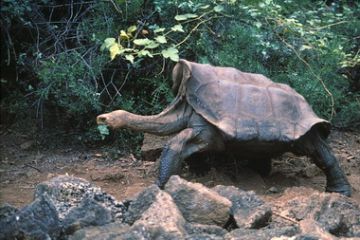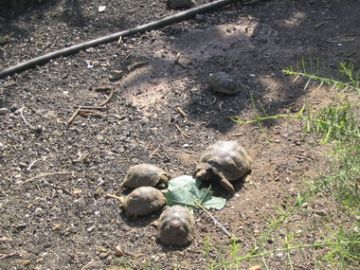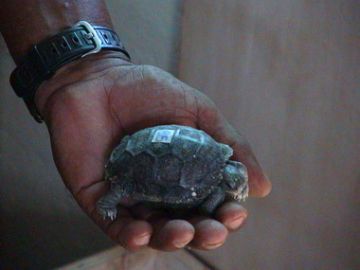Leonor Stjepic
Executive Director, Galapagos Conservation Trust, 5 Derby Street, London W1J 7AB
Presented to the BCG Symposium at the Open University, Milton Keynes, 19th March 2005
The Galapagos Islands, 1000 km off the coast of Ecuador, are also known as the 'Enchanted Islands', and for good reason. These unique, volcanic and mysterious islands have often amazed and enchanted visitors since they were first discovered in 1535. When Tomas de Berlanga found the islands four hundred and seventy years ago, he found islands that had little to recommend them. There was little fresh water and he considered them 'worthless'. However, he did note that there were tortoises each of which 'could carry a man on top of himself'.
The tortoises noted by Tomas de Berlanga came from the South American mainland where, it is believed, they lived about 20 million years ago. We cannot know how they arrived in Galapagos, but scientists conjecture that they may have drifted across on huge rafts of vegetation. Their scaly feet were able to withstand the harsh, rocky ground on some of the islands and their strong, curved, knife-like mouths allowed them to feed on spiny cactus where there was no other vegetation. It is amazing to think that, at one time, perhaps hundreds of thousands of giant tortoises may have roamed the Galapagos Islands. We cannot know – what we do know is that they were very numerous and lived in the islands with few natural predators.
The islands remained mostly a lost world until the 18th century when they began to be used by pirates as a base, and later by whalers during the beginning of the 19th century. The British pirate, Ambrose Cowley, noted that 'The land turtle are here so numerous, that five or six hundred men might subsist on them alone for several months, without any other sort of provisions. They are extraordinarily large and fat, and so sweet that no pullet eats more pleasantly.' More importantly for these early sailors, they found that in islands with few natural water resources, there was a source of water in the bladder and pericardium of the giant tortoises. For these early visitors, the giant tortoises were easy to catch, a source of food and water. Before refrigeration, giant tortoises must have been seen as a gift from heaven. They did not need feeding or water for long periods of time and provided fresh meat. In fact one giant tortoise, having been lost in the hold of a ship, was found alive two years later!
During the early 19th century, whalers found that the waters of the Galapagos Islands were rich in whales. For the whalers, like the pirates before them, the giant tortoises were an important source of food and water. By the time Darwin visited in 1835, it was common for visiting sailors to undertake tortoise hunting expeditions. We cannot tell how many giant tortoises were killed in this way, but studies of early American whalers’ log books indicate that around 100,000 giant tortoises were removed from Galapagos before 1830.
There are two main types of giant tortoise in Galapagos which are easily identified by visitors – those with a dome shaped shell, and the saddlebacks (so called because their carapaces appear to be like those of an old fashioned saddle). In fact, 'galapagos' is an old Spanish word for a saddle. However, as far back as 1812, Captain David Porter of the Essex observed that giant tortoises from the various Galapagos Islands had differently shaped shells. Vice Consul Mr Lawson remarked the same to Darwin in 1835 – a comment that was to have an impact on the young naturalist. If each giant tortoise from Galapagos was a different species, but came from a common ancestor, the implication was that they had evolved rather than each species having been 'created'.
The threats to the giant tortoises in the 20th and 21st centuries are the non-native species such as goats, donkeys, cattle and wild pigs. They were originally brought by early settlers and sailors. As early as 1813, Captain Porter left goats on Santiago with the idea that future visitors ‘may perhaps obtain here an abundant supply of goats’ meat, for unmolested as they will be in the interior of this island, it is probable that their increase will be very rapid’. He was right – when Project Isabela started four years ago, it was calculated that there were 150,000 goats on Northern Isabela alone. The goats eat all the vegetation, leaving the landscape looking like a desert. With no vegetation, the thin, dry soil of the Galapagos is often eroded away. The giant tortoises depend on the vegetation for their food and for shade from the hot sun for themselves and their eggs. The vegetation also provides moisture for drinking and, where there is lush vegetation, one often finds shallow pools that the giant tortoises can bask in. Feral cats, dogs, pigs and goats eat the tortoise eggs or young hatchlings. In addition, the goats, wild donkeys, pigs and cattle crush the tortoise eggs as they travel the islands. All in all, from being a creature that had few natural predators, the Galapagos giant tortoises are facing a myriad of threats from introduced non-native species.
By the 1960s, the giant tortoise population of Galapagos was seriously under threat. Several tortoise species were extinct and, although a Pinta tortoise was found in 1972, 'Lonesome George' (as he was nicknamed) is the only remaining Pinta tortoise in the world. He now lives at the Charles Darwin Research Station. Conservationists at the Charles Darwin Research Station realised that there had to be a three pronged attack on the problem – eradication of non-native species, effective record keeping of the tortoise numbers and ex-situ breeding of threatened species.
For a number of years, the British Chelonia Group has been supporting the tortoise breeding centre at the Charles Darwin Research Station (via their annual donation to the Galapagos Conservation Trust). Scientists from the Station collect eggs at 10-15 weeks old and take them back to the Station. There they are put into the hatching shed and, when the eggs hatch, they are left in a dark box for 30 days to harden before being transferred to open pens. At night they need to be put into rat-proof boxes to protect them from the non-native rats that, sadly, live in Santa Cruz. At four years old they are released into the wild.
The tortoise breeding centre has been a huge success. In fact, without it the Espanola tortoise would have become extinct. In 1968 there were only 14 Espanola tortoises left – in 2000 the 1000th Espanola tortoise was released into the wild and the population is thriving.
| Origin of Tortoises | Total 1 June 2003 | Hatched | Died | Repatriated | Total 31 May 2004 |
|---|
| Cazuela | 31 | 19 | 5 | 0 | 45 |
| San Pedro | 22 | 6 | 4 | 0 | 24 |
| Roca Union | 127 | 61 | 19 | 10 | 159 |
| Cinco Cerros | 520 | 21 | 24 | 114 | 403 |
| Cerro Palma | 36 | 16 | 5 | 0 | 47 |
| TOTAL | 736 | 123 | 57 | 124 | 678 |
Table. Number of tortoises (G.guntheri) and their status in the captive breeding centre in Puerto Villamil, Isabela, Galapagos Conservation Trust.
In addition, the Galapagos National Park and the Charles Darwin Research Station have been working to eradicate non-native species from the islands – the best known being Project Isabela, which is the largest habitat restoration project in the world and is fast on its way to becoming a huge success. Scientists at the Charles Darwin Research Station have also been carrying out vital research work that helps the Galapagos National Park create conservation policy that will help safeguard the populations of the Galapagos giant tortoises.
The UK registered charity the Galapagos Conservation Trust has been working for the last ten years to help protect and conserve the unique biodiversity of the Galapagos Islands. We work with local organisations – including the Charles Darwin Research Station and the Galapagos National Park. Sadly, the challenges facing us continue, and we need to continue to raise funds to help the conservation work in the islands. It would be heartbreaking if the Galapagos giant tortoise – who has survived hundreds of years of persecution and has lived in the islands for millions of years – were not around for future generations.
Luckily we have been able to depend on the generosity of donors such as the British Chelonia Group and we hope that you will continue to support this work. On behalf of the giant tortoises of Galapagos, I would like to say a big ‘THANK YOU’ to all of you.
Testudo Volume Six Number Two 2005
Top



